Fault finding, Power transmission
VW Bora 1999 βûΛ , VW Eos 2006 βûΛ ,
VW Golf 4 1998 βûΛ , VW Golf 5 2004 βûΛ ,
VW Golf Plus 2005 βûΛ , VW Passat B6 2006 βûΛ ,
VW Polo 4 2002 βûΛ , VW Sharan 1996 βûΛ ,
VW Touran 2003 βûΛ
Clutch
Complaints regarding clutch and clutch mechanism
Before carrying out any clutch repairs, the customer complaint must always be checked and the cause traced. When doing this, check whether the complaint is actually attributable to the clutch or whether adjustment of the selector mechanism is the cause of the problem.
The repair measures listed in this fault finding programme are to be carried out as described in the relevant workshop manuals.
| Complaint | Fault description | Measure |
| Clutch pedal does not return to original position | - Air in line system | βÄ™ Bleed line system; replenish brake fluid. |
| - Line system, master or slave cylinder leaking. | βÄ™ Renew defective part, bleed line system; replenish brake fluid. | |
| - Return spring (if fitted) defective. | βÄ™ Renew return spring. | |
| - Actuator elements in bell housing stiff. | βÄ™ Clean, lubricate bearing points. Repair bearing as necessary. | |
| - Clutch release bearing canted on guide sleeve, worn. | βÄ™ Renew guide sleeve and release bearing. | |
| - Diaphragm spring of pressure plate broken. | βÄ™ Renew pressure plate. |
| Complaint | Fault description | Measure |
| Actuation pressure at clutch pedal too high | - Over-centre spring defective. | βÄ™ Renew over-centre spring. |
| - Return spring (if fitted) too strong,
incorrect return spring. | βÄ™ Allocate return spring according to
β΅£ Electronic parts catalogue βÄ€ETKAβÄù . | |
| - Clutch release pressure increased
due to wear in clutch friction linings. | βÄ™ Explain situation to customer
(release pressure rises as wear increases). βÄ™ Renew clutch plate if distance from lining to rivet is less than 0.1 mm. | |
| - Actuator elements in bell housing stiff. | βÄ™ Clean, lubricate bearing points.
Repair bearing bushes as necessary. | |
| - Clutch release bearing canted on
guide sleeve, worn. | βÄ™ Renew defective parts. | |
| - Contact surface of release
bearing/release lever worn/scored. | βÄ™ Renew defective parts. | |
| - Pressure plate has incorrect spring rating. | βÄ™ Allocate according to β΅£ Electronic parts
catalogue βÄ€ETKAβÄù . | |
| - Clutch plate stiff/sticking on spline. | βÄ™ Check splines on hub for damage (burrs).
Renew clutch plate as necessary. βÄ™ Clean splines of hub and input shaft of corrosion and lubrication deposits and lubricate with grease G 000 100. Move clutch plate back and forth, remove excess grease. | |
| Manual gearbox 02K only:
- Clutch push rod and release plate (pressure plate) stiff. | βÄ™ Lubricate contact points lightly with G 000 100.
βÄ™ Lubricate clutch push rod lightly. |
| Complaint | Fault description | Measure |
| Noises when clutch is depressed | βÄ€Only Sharan:βÄù
- Clutch pedal stiff, bearing points misaligned. - Over-centre spring bearing dry, stiff, misaligned. | βÄ™ Clean, lubricate bearing points.
Repair bearing as necessary. |
| - Return spring (if fitted) causing
noises. | βÄ™ Grease bearing points. | |
| - Release bearing defective,
guide for release bearing not OK, contact surface worn. | βÄ™ Always renew noisy release
bearings. βÄ™ Renew guide sleeves if damaged. | |
| - Contact surface (diaphragm spring
ends) of pressure plate defective (bent, broken). Release bearing off-centre. | βÄ™ Renew pressure plate.
βÄ™ Check and, if necessary, renew release bearing and guide sleeve. βÄ™ Check position of release lever. βÄ™ Check locating sleeves. | |
| - Needle roller bearing in crankshaft
(if fitted) defective. Offset engine/gearbox. | βÄ™ Renew, lubricate with MoS2 grease.
βÄ™ Check locating sleeves. | |
| - Clutch plate installed wrong way round. | βÄ™ Rectify installation position. | |
| - Incorrect clutch plate installed. | βÄ™ Allocate clutch plate according to
β΅£ Electronic parts catalogue βÄ€ETKAβÄù . |
| Complaint | Fault description | Measure |
| Scratching noises when engaging
forwards or reverse gear, selector mechanism sticking, catching, stiff, gear selection not possible, clutch has no function | - Air in system, clutch does not
separate fully. | βÄ™ Bleed system; check system,
replenish brake fluid. |
| - Master/slave cylinder, lines leaking. | βÄ™ Renew defective part, top up
brake fluid, bleed system. | |
| - Travel of clutch pedal insufficient
(carpet, foot mat under pedal), clutch does not fully depress. | βÄ™ Explain situation to customer. | |
| - Pressure plate uneven due to
faulty installation, clutch plate warped due to improper handling. | βÄ™ Check parts, renew as necessary,
observe position of centring pins. βÄ™ If scratching still occurs, check splines of clutch plate on input shaft for ease of movement, check needle roller bearing in crankshaft, repair transmission if necessary. | |
| - Diaphragm spring ends broken
off or bent (faulty installation, release bearing offset). | βÄ™ Renew pressure plate.
βÄ™ Check and, if necessary, renew release bearing, guide sleeve. βÄ™ Check locating sleeves. | |
| Manual gearbox 02K only
- Push rod too short due to wear. | βÄ™ Renew push rod, check release
bearing, renew as necessary. βÄ™ Lubricate contact points of push rod/release bearing lightly with grease G 000 100. | |
| - Clutch plate too thick. | βÄ™ Allocate clutch plate according to
β΅£ Electronic parts catalogue βÄ€ETKAβÄù . | |
| - Lining seized on flywheel (parked
up for long period, high level of humidity). | βÄ™ Lightly rub down friction surfaces
of clutch linings or, in event of heavy corrosion, renew part completely. | |
| - Clutch plate stiff/sticking on
spline. Hub corroded, damaged during installation. Hub profile misaligned on one side. | βÄ™ Check splines on hub for damage.
Renew clutch plate as necessary. βÄ™ Remove corrosion and deposits of grease from hub and shaft. Lubricate shaft lightly with grease G 000 100 . βÄ™ Move clutch plate back and forth, remove excess grease. βÄ™ Check position of locating sleeves if hub profile is misaligned. βÄ™ Check and, if necessary, renew release bearing, guide sleeve, pressure plate and needle roller bearing. | |
| - Pressure plate lift insufficient
(incorrect pressure plate installed). | βÄ™ Allocate pressure plate according to
β΅£ Electronic parts catalogue βÄ€ETKAβÄù . | |
| - Needle roller bearing in crankshaft
(if fitted) defective. Input shaft picked up by crankshaft when clutch is depressed. | βÄ™ Renew needle roller bearing
and lubricate with MoS2 grease. βÄ™ Check locating sleeves and renew if necessary. βÄ™ Check input shaft. | |
| - Engine/gearbox offset excessive
(locating sleeves missing) causing carrier plate of clutch plate to bend. Needle roller bearing in crankshaft (if fitted) defective. | βÄ™ Insert locating sleeves before installing
gearbox. βÄ™ Check clutch plate, pressure plate and needle roller bearing for damage and renew as necessary. | |
| - Linings flown off due excessively high
speed (changing down when speed is too high). - Linings flown off due to clutch being allowed to slip too much when pulling away. | βÄ™ Renew clutch plate. Explain situation to customer. |
| Complaint | Fault description | Measure |
| Load change jolts from acceleration
and abrupt reduction in engine speed | - Assembly mounting too soft. | βÄ™ Explain situation to customer.
Allocate mounting according to β΅£ Electronic parts catalogue βÄ€ETKAβÄù, renew as necessary. |
| - Lumpy engine (not running smoothly). | βÄ™ Check, rectify engine setup. | |
| - Clutch plate installed with damper to prevent loose gears rattling. | βÄ™ Explain situation to customer. | |
| - Needle roller bearing in crankshaft
(if fitted) defective. Offset engine/gearbox. | βÄ™ Renew needle roller bearing and
lubricate with MoS2 grease. βÄ™ Check locating sleeves and renew if necessary. |
| Complaint | Fault description | Measure |
| Clutch slipping, no propulsion or
propulsion poor | - Wrong clutch plate, wrong
pressure plate installed. | βÄ™ Allocate clutch plate and pressure
plate according to β΅£ Electronic parts catalogue βÄ€ETKAβÄù . |
| - Clutch plate worn, burnt, pressure
plate overheated, scores, pressure plate warped from faulty installed, contact pressure of pressure plate insufficient, driving fault, natural wear. | βÄ™ Renew clutch plate.
βÄ™ Renew pressure plate. βÄ™ Explain situation to customer. | |
| - Actuator elements on gearbox stiff. | βÄ™ Clean, lubricate bearing points.
Repair as necessary. | |
| - Clutch plate, pressure plate, flywheel oily.
Shaft seal from engine or gearbox defective. Grease on contact surfaces due to excessive greasing of hub. | βÄ™ Renew clutch plate.
βÄ™ Clean contact surfaces and pressure plate and clean flywheel. βÄ™ Renew shaft seal, remove excess grease from input shaft. | |
| Manual gearbox 02K only
- Seal for push rod in input shaft leaking. Bearing bush for push rod in input shaft misaligned. | βÄ™ Renew seal, clutch plate.
βÄ™ Check bearing bush for push rod, renew as necessary. βÄ™ Clean pressure plate, flywheel. | |
| - Clutch plate installed wrong way round. | βÄ™ Rectify installation, check clutch
plate, renew as necessary. | |
| - Flywheel depth too great or excessive
erosion on lining contact surface. | βÄ™ Allocate flywheel according to
β΅£ Electronic parts catalogue βÄ€ETKAβÄù . βÄ™ Check clutch plate, pressure plate, renew as necessary. | |
| - Slave cylinder with release
bearing leaking. | βÄ™ Renew slave cylinder with release bearing. |
| Complaint | Fault description | Measure |
| Clutch jolts,
assembly shakes | - Air in system | βÄ™ Bleed system, check brake fluid
level, check for leaks. βÄ™ Renew defective part. |
| - Engine not running well | βÄ™ Check, rectify engine setup. | |
| - Driving fault, pulling away speed
too low. | βÄ™ Explain situation to customer. | |
| - Incorrect clutch plate installed. | βÄ™ Allocate clutch plate according
to β΅£ Electronic parts catalogue βÄ€ETKAβÄù . | |
| - Assembly mounting too soft,
misaligned. | βÄ™ Allocate assembly mounting according to
β΅£ Electronic parts catalogue βÄ€ETKAβÄù . | |
| - Clutch lining, contact surface of
pressure plate and flywheel oily (oil seeping from clutch housing). | βÄ™ Check shaft seal of gearbox input
shaft or crankshaft, renew as necessary. βÄ™ Renew clutch plate, clean pressure plate and flywheel. | |
| - Release bearing canted on
guide sleeve, seized (one-sided pressure on diaphragm spring of pressure plate). | βÄ™ Renew release bearing and
guide sleeve. βÄ™ Check actuator elements and bearings for actuator elements. | |
| - Contact surface of pressure
plate has only one-sided lift due to canted release bearing. - Housing of pressure plate warped during assembly. Contact surface of pressure plate has only one-sided lift. | βÄ™ Check contact surface of clutch
lining to flywheel, pressure plate and diaphragm spring, renew pressure plate as necessary. βÄ™ Renew release bearing and guide sleeve. | |
| - Input shaft has been packed
with too much grease (signs of grease on clutch plate, pressure plate and flywheel). | βÄ™ Clean grease off pressure plate
and flywheel, renew if there are signs of damage (rattle marks, signs of overheating, scores). βÄ™ Remove traces of grease from hub and shaft, lubricate shaft lightly with grease -G 000 100- . βÄ™ Move clutch plate back and forth, remove excess grease. | |
| - Slave cylinder with release
bearing is not flat on bell housing. | βÄ™ Check threaded connections of
slave cylinder to bell housing. |
| Complaint | Fault description | Measure |
| βÄ€KnockingβÄù noise when depressing
clutch | - Slow mass/input shaft is accelerated
by abrupt clutch depression. Teeth of meshed gear wheels strike; on clutch plates with damper, noise is amplified due to damper coming into contact. | βÄ™ Explain situation to customer. |
| Complaint | Fault description | Measure |
| Noises at idle | - Torsional damper spring broken. | βÄ™ Renew clutch plate. |
| - Clutch plate installed without
damper (rattling at idle). | βÄ™ Install clutch plate with damper. | |
| - Pressure plate warped, broken,
unbalanced. | βÄ™ Renew pressure plate. | |
| - Lumpy engine (not running
smoothly). | βÄ™ Check engine setup, rectify as
necessary. | |
| - Engine/gearbox offset too great
(locating sleeves missing). | βÄ™ Insert locating sleeves before installing gearbox. | |
| - Intermediate plate rubbing on flywheel. | βÄ™ Mount intermediate plate on sealing
flange and position on locating sleeves. |
Checking clutch mechanism
(slave cylinder is bolted from outside on clutch housing)
βÄ™ Check if clutch is slipping.
Renew clutch if necessary
βÄ€1βÄù The pedal return function must not be hindered by additional
foot mats or foot mats pushed underneath.
βÄ€2βÄù Check level of brake fluid in brake fluid reservoir
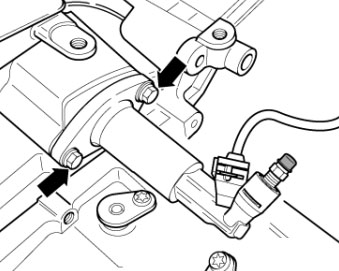 |
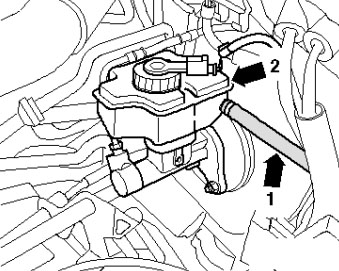 |
Note
- The clutch hydraulics is connected to the brake fluid reservoir via a supply hose -arrow 1- and clip -arrow 2-.
- If no or very little brake fluid is in this chamber, the system may be leaking.
βÄ€3βÄù Check clutch hydraulics for external leaks:
βÄΔ The clutch system must be bled
- Master cylinder
- Supply hose
- Line between master cylinder and slave cylinder
- Connecting points (clip fit and threaded connections) also in areas that cannot be seen.
- Slave cylinder
Symptoms for external leaks are, for example, signs of fluid in or on noise damper under gearbox.
βÄ€4βÄù Check for correct routing of line between master cylinder and slave cylinder. The line must not be kinked or trapped.
βÄ€5βÄù Depress clutch pedal. To do this, the pedal must be depressed and held over the entire pedal travel in five different positions for approx. 20 seconds (tests different application pressures in the hydraulic system). A second person thereby checks whether any fluid escapes at the positions mentioned in βÄ€3βÄù. The first position
also checks whether the clutch pedal drops on its own when pressure is maintained.
βÄ€6βÄù Remove slave cylinder from gearbox. Do not open lines and check boot for signs of leaking brake fluid.
Carefully pull boot off plunger -arrow-.
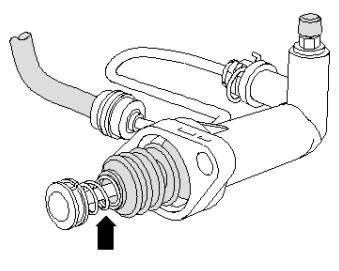 |
βÄ€7βÄù Check function of clutch mechanism during a road test
Checking clutch mechanism
(slave cylinder is located inside clutch housing)
Note
Only the bleeder -A- is visible when the slave cylinder is located inside the clutch housing.
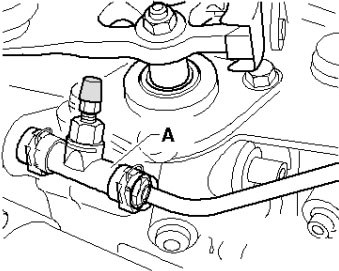 |
βÄ™ Check if clutch is slipping.
Renew clutch if necessary
βÄ€1βÄù The pedal return function must not be hindered by additional foot mats or foot mats pushed underneath.
βÄ€2βÄù Check level of brake fluid in brake fluid reservoir
Note
- Note that the clutch hydraulics is connected to the brake fluid reservoir via a supply hose -arrow 1- and clip -arrow 2-.
 |
- If no or very little brake fluid is in this chamber, the system may be leaking.
βÄ€3βÄù Check clutch hydraulics for external leaks:
βÄΔ The clutch system must be bled
- Master cylinder
- Line between master cylinder and slave cylinder
- Supply hose
- Connecting points (clip fit and threaded connections) also in areas that cannot be seen.
Symptoms for external leaks are, for example, signs of fluid in or on noise damper under gearbox.
βÄ€4βÄù Check for correct routing of line between master cylinder and slave cylinder. The line must not be kinked or trapped.
βÄ€5βÄù Depress clutch pedal. To do this, the pedal must be depressed and held over the entire pedal travel in five different positions for approx. 20 seconds (tests different application pressures in the hydraulic system). A second person thereby checks whether any fluid escapes at the positions mentioned in βÄ€3βÄù. The first position
also checks whether the clutch pedal drops on its own when pressure is maintained.
βÄ€6βÄù Remove gearbox. Remove slave cylinder and check for signs of leaking brake fluid.
Note that on some slave cylinders -A- the supply line is separate -arrow-.
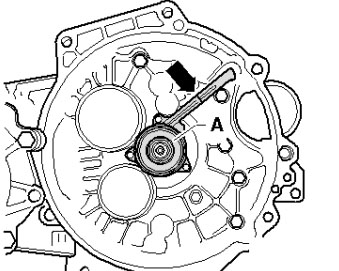 |
βÄ€7βÄù Check function of clutch mechanism during a road test.
Controls, housing
Complaints regarding the selector mechanism
Before carrying out any selector mechanism repairs, the customer complaint must always be checked and the cause traced. When doing this, check whether the complaint is actually attributable to the selector mechanism or its adjustment. It may be necessary to check whether the complaint originates from the
clutch and clutch mechanism.
The repair measures listed in this fault finding programme are to be carried out as described in the relevant workshop manuals.
| Complaint | Fault description | Measure |
| Scratching noises when engaging
forwards or reverse gear, selector mechanism sticking, catching, stiff, gear selection not possible, clutch has no function | - Adjustment of selector mechaβÄê
nism. | βÄ™ Checking and rectifying. |
| - Bearing for selector level and
selector mechanism not lubricaβÄê ted, misaligned. | βÄ™ Grease selector mechanism,
renew defective parts. | |
| - Needle roller bearing in crankβÄê
shaft (if fitted) defective. Input shaft picked up by crankshaft when clutch is depressed. | βÄ™ Renew needle roller bearing
and lubricate with MoS2 grease. βÄ™ Check locating sleeves and renew if necessary. βÄ™ Check input shaft. | |
| - Synchronisation and/or selector
mechanism in gearbox defecβÄê tive. | βÄ™ Repair gearbox. |
| Complaint | Fault description | Measure |
| βÄ€KnockingβÄù noise when depressing
clutch | - Slow mass/input shaft is accelβÄê
erated by abrupt clutch depresβÄê sion. Teeth of meshed gear wheels strike; on clutch plates with damper, noise is amplified due to damper coming into conβÄê tact. | βÄ™ Explain situation to customer. |
–ö–Α–Κ –Ζ–¥–Β―¹―¨ –Ϋ–Α–Ι―²–Η –Ϋ―É–Ε–Ϋ―É―é –Η–Ϋ―³–Ψ―Ä–Φ–Α―Ü–Η―é?
–†–Α―¹―à–Η―³―Ä–Ψ–≤–Κ–Α –Ζ–Α–≤–Ψ–¥―¹–Κ–Ψ–Ι –Κ–Ψ–Φ–Ω–Μ–Β–Κ―²–Α―Ü–Η–Η –Α–≤―²–Ψ–Φ–Ψ–±–Η–Μ―è (–Α–Ϋ–≥–Μ.)
–†–Α―¹―à–Η―³―Ä–Ψ–≤–Κ–Α –Ζ–Α–≤–Ψ–¥―¹–Κ–Ψ–Ι –Κ–Ψ–Φ–Ω–Μ–Β–Κ―²–Α―Ü–Η–Η VAG –Ϋ–Α ―Ä―É―¹―¹–Κ–Ψ–Φ!
–î–Η–Α–≥–Ϋ–Ψ―¹―²–Η–Κ–Α –Λ–Ψ–Μ―¨–Κ―¹–≤–Α–≥–Β–Ϋ, –ê―É–¥–Η, –®–Κ–Ψ–¥–Α, –Γ–Β–Α―², –Κ–Ψ–¥―΄ –Ψ―à–Η–±–Ψ–Κ.
–ï―¹–Μ–Η –≤―΄ –Ϋ–Β –Ϋ–Α―à–Μ–Η –Η–Ϋ―³–Ψ―Ä–Φ–Α―Ü–Η―é –Ω–Ψ ―¹–≤–Ψ–Β–Φ―É –Α–≤―²–Ψ–Φ–Ψ–±–Η–Μ―é - –Ω–Ψ―¹–Φ–Ψ―²―Ä–Η―²–Β –Β–Β –Ϋ–Α –Α–≤―²–Ψ–Φ–Ψ–±–Η–Μ–Η –Ω–Ψ―¹―²―Ä–Ψ–Β–Ϋ–Ϋ―΄–Β –Ϋ–Α –Ω–Μ–Α―²―³–Ψ―Ä–Φ–Β –≤–Α―à–Β–≥–Ψ –Α–≤―²–Ψ.
–Γ –±–Ψ–Μ―¨―à–Ψ–Ι –¥–Ψ–Μ–Β–Ι –≤–Β―Ä–Ψ―è―²–Ϋ–Ψ―¹―²–Η –Η–Ϋ―³–Ψ―Ä–Φ–Α―Ü–Η―è –Ω–Ψ ―Ä–Β–Φ–Ψ–Ϋ―²―É –Η –Ψ–±―¹–Μ―É–Ε–Η–≤–Α–Ϋ–Η―é –Ω–Ψ–¥–Ψ–Ι–¥–Β―² –Η –¥–Μ―è –£–Α―à–Β–≥–Ψ –Α–≤―²–Ψ.
